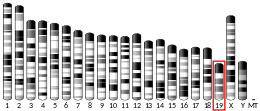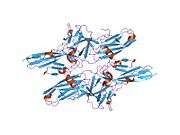FGF8
Fibroblast growth factor 8 is a protein that in humans is encoded by the FGF8 gene.[5][6]
Function
The protein encoded by this gene is a member of the fibroblast growth factor (FGF) family. FGF family members possess broad mitogenic and cell survival activities, and are involved in a variety of biological processes, including embryonic development, cell growth, morphogenesis, tissue repair, tumor growth and invasion.[6]
Fgf8 is important and necessary for setting up and maintaining the midbrain/hindbrain border (or mesencephalon/met-encephalon border) which plays the vital role of “organizer” in development, like the Spemann “organizer” of the gastrulating embryo. Fgf8 is expressed in the region where Otx2 and Gbx2 cross inhibit each other and is maintained expression by this interaction. Once expressed, the Fgf8 induces other transcription factors to form cross-regulatory loops between cells, thus the border is established. Through development, the Fgf8 goes to regulate the growth and differentiation of progenitor cells in this region to produce ultimate structure of midbrain and hindbrain.[7] Crossely’s experiment proves that the Fgf8 is sufficient to induce the repatterning of midbrain and hindbrain structure.[8]
In the development of forebrain, cortical patterning centers are the boundaries or poles of cortical primordium, where multiple BMP and WNT genes are expressed. Besides, at the anterior pole several FGF family including Fgf3, 8,17 and 18 overlap in expression.[9] The similarity in cortical gene expression in Emx2 mutants and mice in which the anterior FGF8 source is augmented suggests that FGF8 controls the graded expression (low anterior, high posterior) of Emx2 in the cortical primordium. Emx2 is one of the protomap molecular determinants that prove to be closely interacted with Pax6. Emx2 and Pax6 are expressed in opposing gradients along the A/P axis of the cortical primordium and cooperate to set up area pattern. Fgf8 and Emx2 antagonize each other to create the development map. Fgf8 promotes the development of anterior part and suppresses posterior fate, while the Emx2 does the reverse. What's more, FGF8 manipulations suggest FGF8 controls the cortical graded expression of COUP-TF1.[10] Moreover, the sharpness of both COUPTF1 and COUP-TF2 expression borders would be expected of genes involved in boundary specification. Thus, the interaction between them regulates the A/P axis of cortical primordium and directs the development map of cortical area.
FGF8 signaling from the apical ectodermal ridge (AER), which borders the distal end of the limb bud[11], is necessary for forming normal limbs. In the absence of FGF8, limb buds can be reduced in size, hypoplasia or aplasia of bones or digits within the three limb segments may occur, as well as delays in subsequent expressions of other genes (Shh or FGF4). FGF8 is responsible for cell proliferation and survival, as well. Loss of function or decreased expression could result in the malformation or absence of essential limb components. Studies have shown that the forelimbs tend to be more affected by the loss of FGF8 signaling than the hindlimbs[12] and the loss tends to affect the proximal components more heavily than the distal components.[13] FGF8 not only aids in the formation of the limb bud and skeletal components of the limb, but the tendons within the limb are affected by it near the portions closest to the muscle extremities.[14] This diffusible polypeptide is responsible for inducing the limb bud, then inducing and maintaining sonic hedgehog expression in the established limb bud promoting outgrowth of the limb. Evidence for this comes from a study done by Crossley and his colleagues, in which FGF8 soaked beads were surgically used to replace AER areas with the beads.[15] These studies showed that ectopic limbs formed either fully functional or mostly functional limbs near the normal limbs or limb areas. FGF8 has also been recorded to regulate craniofacial structure formation, including the teeth, palate, mandible, and salivary glands.[16] Decreased expression can result in the absence of molar teeth, failure to close the palate, or decreased mandible size.
FGF8 has been documented to play a role in oralmaxillogacial diseases and CRISPR-cas9 gene targeting on FGF8 may be key in treating these diseases. Cleft lip and/or palate (CLP) genome wide gene analysis shows a D73H missense mutation in the FGF8 gene[17] which reduces the binding affinity of FGF8. Loss of Tbx1 and Tfap2 can result in proliferation and apoptosis in the palate cells increasing the risk of CLP. Overexpression of FGF8 due to misregulation of the Gli processing gene may result in cliliopathies. Agnathia, a malformation of the mandible, is often a lethal condition that comes from the absence of BMP4 regulators (noggin and chordin), resulting in high levels of BMP4 signaling, which in turn drastically reduces FGF8 signaling, increasing cell death during mandibular outgrowth.[18] Lastly, the ability for FGF8 to regulate cell proliferation has caused interest in its affects on tumors or squamous cell carcinoma. CRISPR-cas9 gene targeting methods are currently being studied to determine if they are the key to solving FGF8 mutations associated with oral diseases.
Clinical significance
This protein is known to be a factor that supports androgen and anchorage independent growth of mammary tumor cells. Overexpression of this gene has been shown to increase tumor growth and angiogenesis. The adult expression of this gene is restricted to testes and ovaries. Temporal and spatial pattern of this gene expression suggests its function as an embryonic epithelial factor. Studies of the mouse and chick homologs reveal roles in midbrain and limb development, organogenesis, embryo gastrulation and left-right axis determination. The alternative splicing of this gene results in four transcript variants.[6]
References
- GRCh38: Ensembl release 89: ENSG00000107831 - Ensembl, May 2017
- GRCm38: Ensembl release 89: ENSMUSG00000025219 - Ensembl, May 2017
- "Human PubMed Reference:". National Center for Biotechnology Information, U.S. National Library of Medicine.
- "Mouse PubMed Reference:". National Center for Biotechnology Information, U.S. National Library of Medicine.
- White RA, Dowler LL, Angeloni SV, Pasztor LM, MacArthur CA (Apr 1996). "Assignment of FGF8 to human chromosome 10q25-q26: mutations in FGF8 may be responsible for some types of acrocephalosyndactyly linked to this region". Genomics. 30 (1): 109–11. doi:10.1006/geno.1995.0020. PMID 8595889.
- "Entrez Gene: FGF8 fibroblast growth factor 8 (androgen-induced)".
- Harris WA, Sanes DH, Reh TA (2011). Development of the Nervous System, Third Edition. Boston: Academic Press. pp. 33–34. ISBN 978-0-12-374539-2.
- Crossley PH, Martin GR (February 1995). "The mouse Fgf8 gene encodes a family of polypeptides and is expressed in regions that direct outgrowth and patterning in the developing embryo". Development. 121 (2): 439–51. PMID 7768185.
- Grove EA, Fukuchi-Shimogori T (2003). "Generating the cerebral cortical area map". Annu. Rev. Neurosci. 26: 355–80. doi:10.1146/annurev.neuro.26.041002.131137. PMID 14527269.
- Rebsam A, Seif I, Gaspar P (October 2002). "Refinement of thalamocortical arbors and emergence of barrel domains in primary somatosensory cortex: a study of normal and monoamine oxidase A knock-out mice". J. Neurosci. 22 (19): 8541–8552. doi:10.1523/JNEUROSCI.22-19-08541.2002. PMC 6757778. PMID 12351728.
- Lewandoski M, Sun X, Martin GR (December 2000). "Fgf8 signaling from the AER is essential for normal limb development". Nature Genetics. 26 (4): 400–463. doi:10.1038/82609. PMID 11101846.CS1 maint: uses authors parameter (link)
- Lewandoski M, Sun X, Martin GR (December 2000). "Fgf8 signaling from the AER is essential for normal limb development". Nature Genetics. 26 (4): 400–463. doi:10.1038/82609. PMID 11101846.CS1 maint: uses authors parameter (link)
- Moon AM, Capecchi MR (December 2000). "Fgf8 is required for outgrowth and patterning of the limbs". Nat Genet. 26 (4): 455–459. doi:10.1038/82601. PMC 2001274. PMID 11101845.CS1 maint: uses authors parameter (link)
- Edom-Vovard F, Bonnin MA, Duprez D (June 2001). "Fgf8 transcripts are located in tendons during embryonic chick limb development". Mechanisms of Development. 108 (1–2): 203–206. doi:10.1016/S0925-4773(01)00483-X. PMID 11578876.CS1 maint: uses authors parameter (link)
- Crossley PH, Minowada G, MacArthur CA, Martin GR (January 1996). "Roles for FGF8 in the Induction, Initiation, and Maintenance of Chick Limb Development". Cell. 84 (1): 127–136. doi:10.1016/S0092-8674(00)80999-X. PMID 8548816.CS1 maint: uses authors parameter (link)
- Hao Y, Tang S, Yuan Y, Liu R, Chen Q (November 2019). "Roles of FGF8 subfamily in embryogenesis and oral-maxillogacial diseases (Review)". International Journal of Oncology. 54: 797–806.CS1 maint: uses authors parameter (link)
- Hao Y, Tang S, Yuan Y, Liu R, Chen Q (November 2019). "Roles of FGF8 subfamily in embryogenesis and oral-maxillogacial diseases (Review)". International Journal of Oncology. 54: 797–806.CS1 maint: uses authors parameter (link)
- Hao Y, Tang S, Yuan Y, Liu R, Chen Q (November 2019). "Roles of FGF8 subfamily in embryogenesis and oral-maxillogacial diseases (Review)". International Journal of Oncology. 54: 797–806.CS1 maint: uses authors parameter (link)
Further reading
- Powers CJ, McLeskey SW, Wellstein A (2000). "Fibroblast growth factors, their receptors and signaling". Endocr. Relat. Cancer. 7 (3): 165–97. CiteSeerX 10.1.1.323.4337. doi:10.1677/erc.0.0070165. PMID 11021964.
- Mattila MM, Härkönen PL (2007). "Role of fibroblast growth factor 8 in growth and progression of hormonal cancer". Cytokine Growth Factor Rev. 18 (3–4): 257–66. doi:10.1016/j.cytogfr.2007.04.010. PMID 17512240.
- Duester G (2007). "Retinoic acid regulation of the somitogenesis clock". Birth Defects Res. C Embryo Today. 81 (2): 84–92. doi:10.1002/bdrc.20092. PMC 2235195. PMID 17600781.
- Tanaka A, Miyamoto K, Matsuo H, et al. (1995). "Human androgen-induced growth factor in prostate and breast cancer cells: its molecular cloning and growth properties". FEBS Lett. 363 (3): 226–30. doi:10.1016/0014-5793(95)00324-3. PMID 7737407.
- Gemel J, Gorry M, Ehrlich GD, MacArthur CA (1996). "Structure and sequence of human FGF8". Genomics. 35 (1): 253–7. doi:10.1006/geno.1996.0349. PMID 8661131.
- Ornitz DM, Xu J, Colvin JS, et al. (1996). "Receptor specificity of the fibroblast growth factor family". J. Biol. Chem. 271 (25): 15292–7. doi:10.1074/jbc.271.25.15292. PMID 8663044.
- Payson RA, Wu J, Liu Y, Chiu IM (1996). "The human FGF-8 gene localizes on chromosome 10q24 and is subjected to induction by androgen in breast cancer cells". Oncogene. 13 (1): 47–53. PMID 8700553.
- Ghosh AK, Shankar DB, Shackleford GM, et al. (1997). "Molecular cloning and characterization of human FGF8 alternative messenger RNA forms". Cell Growth Differ. 7 (10): 1425–34. PMID 8891346.
- Yoshiura K, Leysens NJ, Chang J, et al. (1997). "Genomic structure, sequence, and mapping of human FGF8 with no evidence for its role in craniosynostosis/limb defect syndromes". Am. J. Med. Genet. 72 (3): 354–62. doi:10.1002/(SICI)1096-8628(19971031)72:3<354::AID-AJMG21>3.0.CO;2-R. PMID 9332670.
- Chellaiah A, Yuan W, Chellaiah M, Ornitz DM (2000). "Mapping ligand binding domains in chimeric fibroblast growth factor receptor molecules. Multiple regions determine ligand binding specificity". J. Biol. Chem. 274 (49): 34785–94. doi:10.1074/jbc.274.49.34785. PMID 10574949.
- Loo BB, Darwish KK, Vainikka SS, et al. (2001). "Production and characterization of the extracellular domain of recombinant human fibroblast growth factor receptor 4". Int. J. Biochem. Cell Biol. 32 (5): 489–97. doi:10.1016/S1357-2725(99)00145-4. PMID 10736564.
- Xu J, Liu Z, Ornitz DM (2000). "Temporal and spatial gradients of Fgf8 and Fgf17 regulate proliferation and differentiation of midline cerebellar structures". Development. 127 (9): 1833–43. PMID 10751172.
- Tanaka S, Ueo H, Mafune K, et al. (2001). "A novel isoform of human fibroblast growth factor 8 is induced by androgens and associated with progression of esophageal carcinoma". Dig. Dis. Sci. 46 (5): 1016–21. doi:10.1023/A:1010753826788. PMID 11341643.
- Ruohola JK, Viitanen TP, Valve EM, et al. (2001). "Enhanced invasion and tumor growth of fibroblast growth factor 8b-overexpressing MCF-7 human breast cancer cells". Cancer Res. 61 (10): 4229–37. PMID 11358849.
- Mattila MM, Ruohola JK, Valve EM, et al. (2001). "FGF-8b increases angiogenic capacity and tumor growth of androgen-regulated S115 breast cancer cells". Oncogene. 20 (22): 2791–804. doi:10.1038/sj.onc.1204430. PMID 11420691.
- Zammit C, Coope R, Gomm JJ, et al. (2002). "Fibroblast growth factor 8 is expressed at higher levels in lactating human breast and in breast cancer". Br. J. Cancer. 86 (7): 1097–103. doi:10.1038/sj.bjc.6600213. PMC 2364190. PMID 11953856.
- Brondani V, Klimkait T, Egly JM, Hamy F (2002). "Promoter of FGF8 reveals a unique regulation by unliganded RARalpha". J. Mol. Biol. 319 (3): 715–28. doi:10.1016/S0022-2836(02)00376-5. PMID 12054865.
- Gnanapragasam VJ, Robson CN, Neal DE, Leung HY (2002). "Regulation of FGF8 expression by the androgen receptor in human prostate cancer". Oncogene. 21 (33): 5069–80. doi:10.1038/sj.onc.1205663. PMID 12140757.
External links
- GeneReviews/NCBI/NIH/UW entry on Kallmann syndrome
- FGF8 human gene location in the UCSC Genome Browser.
- FGF8 human gene details in the UCSC Genome Browser.






